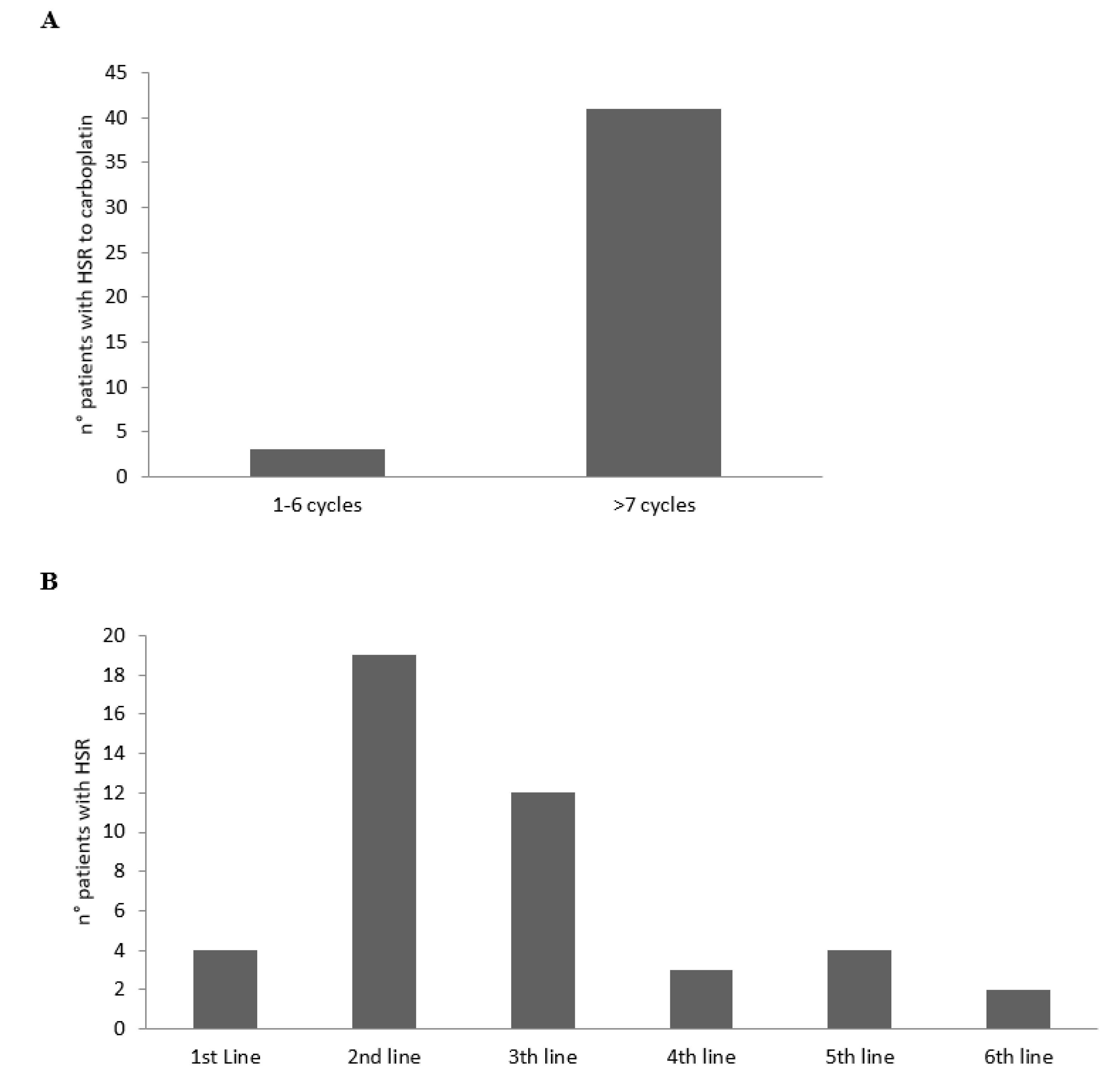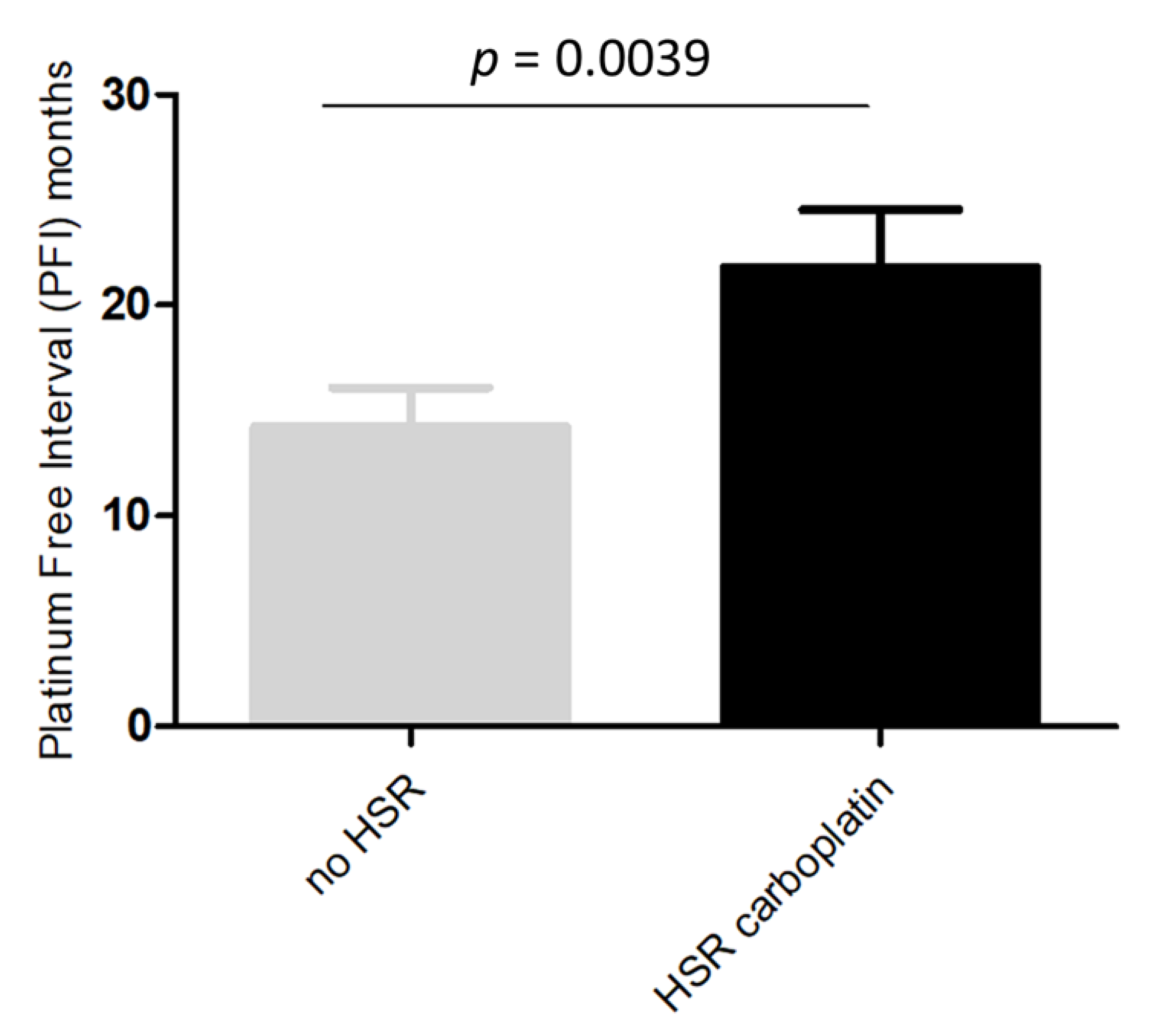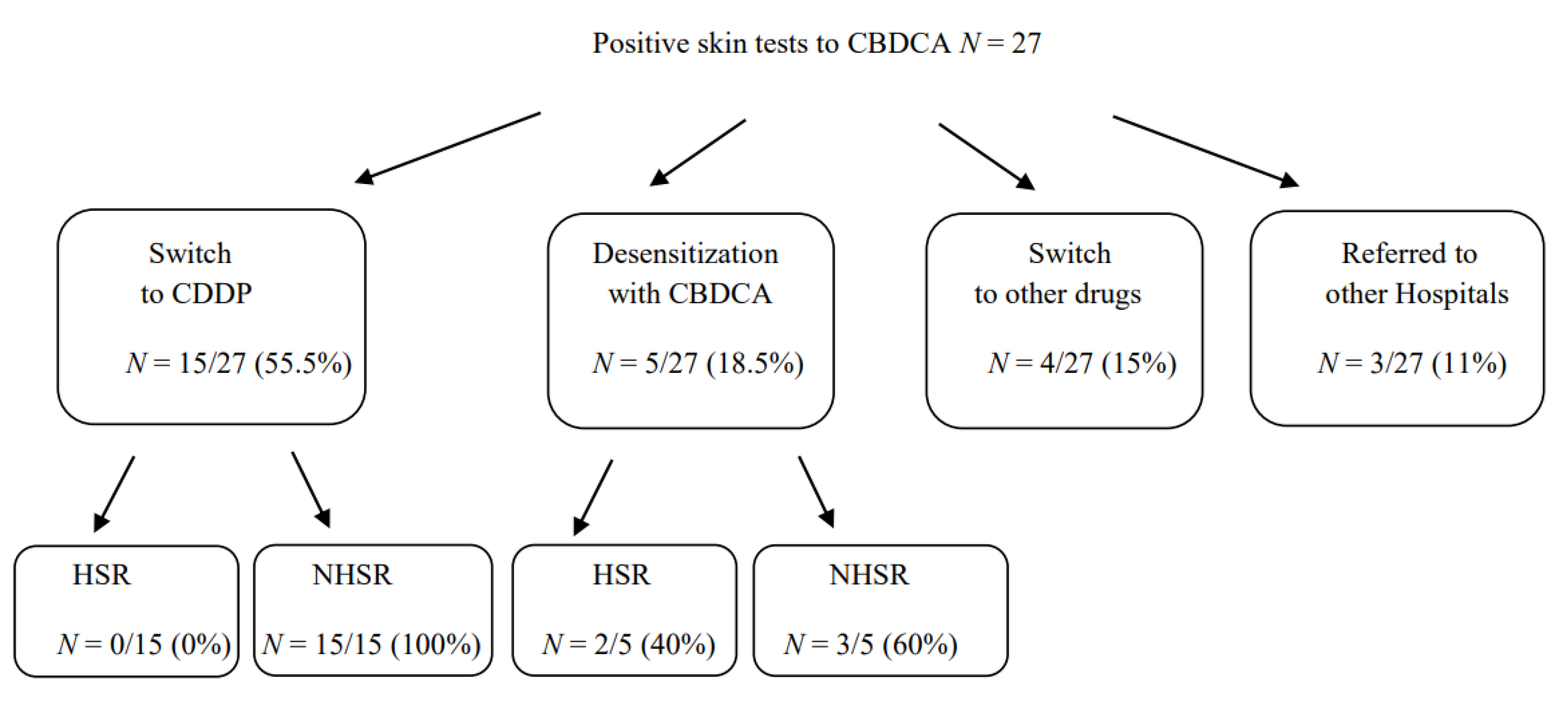The Role of Skin Tests in the Prevention and Diagnosis of Hypersensitivity Reactions to Platinum Agents in Gynecological Cancer: A Single-Center Italian Retrospective Study
Abstract
Simple Summary
Abstract
1. Introduction
2. Materials and Methods
2.1. Patients
2.2. In-Vivo Skin Tests to Platinum Agents
2.3. Statistical Analysis
3. Results
3.1. Study Population and HSRs to Platinum Agents
3.2. HSRs to Platinum Agents
3.3. Role of Skin Tests in the Diagnosis and Prevention of HSRs to Platinum Agents
3.4. Therapeutic Approaches in Patients with HSR to CBDCA with Positive Skin Tests
4. Discussion
5. Conclusions
Author Contributions
Funding
Institutional Review Board Statement
Informed Consent Statement
Data Availability Statement
Conflicts of Interest
References
- Polyzos, A.; Tsavaris, N.; Kosmas, C.; Arnaouti, T.; Kalahanis, N.; Tsigris, C.; Giannopoulos, A.; Karatzas, G.; Giannikos, L.; Sfikakis, P.P. Hypersensitivity reactions to carboplatin administration are common but not always severe: A 10-year experience. Oncology 2001, 61, 129–133. [Google Scholar] [CrossRef]
- Sliesoraitis, S.; Chikhale, P.J. Carboplatin hypersensitivity. Int. J. Gynecol. Cancer 2005, 15, 13–18. [Google Scholar] [CrossRef]
- Navo, M.; Kunthur, A.; Badell, M.L.; Coffer, L.W., 2nd; Markman, M.; Brown, J.; Smith, J.A. Evaluation of the incidence of carboplatin hypersensitivity reactions in cancer patients. Gynecol. Oncol. 2006, 103, 608–613. [Google Scholar] [CrossRef]
- Markman, M.; Kennedy, A.; Webster, K.; Elson, P.; Peterson, G.; Kulp, B.; Belinson, J. Clinical features of hypersensitivity reactions to carboplatin. J. Clin. Oncol. 1999, 17, 1141. [Google Scholar] [CrossRef]
- Caiado, J.; Venemalm, L.; Pereira-Santos, M.C.; Costa, L.; Pereira Barbosa, M.; Castells, M. Carboplatin-, oxaliplatin-, and cisplatin-specific IgE: Cross-reactivity and value in the diagnosis of carboplatin and oxaliplatin allergy. J. Allergy Clin. Immunol. Pract. 2013, 1, 494–500. [Google Scholar] [CrossRef]
- Pasteur, J.; Favier, L.; Pernot, C.; Guerriaud, M.; Bernigaud, C.; Lepage, C.; Jouve, J.-L.; Isambert, N.; Collet, E. Low cross-reactivity between cisplatin and other platinum salts. J. Allergy Clin. Immunol. Pract. 2019, 7, 1894–1900. [Google Scholar] [CrossRef]
- Gadducci, A.; Tana, R.; Teti, G.; Zanca, G.; Fanucchi, A.; Genazzani, A.R. Analysis of the pattern of hypersensitivity reactions in patients receiving carboplatin retreatment for recurrent ovarian cancer. Int. J. Gynecol. Cancer 2008, 18, 615–620. [Google Scholar] [CrossRef]
- Caiado, J.; Castells, M. Presentation and diagnosis of hypersensitivity to platinum drugs. Curr. Allergy Asthma Rep. 2015, 15, 15. [Google Scholar] [CrossRef]
- Moon, D.H.; Lee, J.M.; Noonan, A.M.; Annunziata, C.M.; Minasian, L.; Houston, N.; Hays, J.L.; Kohn, E.C. Deleterious BRCA1/2 mutation is an independent risk factor for carboplatin hypersensitivity reactions. Br. J. Cancer 2013, 109, 1072–1078. [Google Scholar] [CrossRef]
- Pagani, M.; Venemalm, L.; Bonnadona, P.; Vescovi, P.P.; Botelho, C.; Cernadas, J.R. An experimental biological test to diagnose hypersensitivity reactions to carboplatin: New horizons for an old problem. Jpn. J. Clin. Oncol. 2012, 42, 347–350. [Google Scholar] [CrossRef][Green Version]
- Zanotti, K.M.; Rybicki, L.A.; Kennedy, A.W.; Belinson, J.L.; Webster, K.D.; Kulp, B.; Peterson, G.; Markman, M. Carboplatin skin testing: A skin-testing protocol for predicting hypersensitivity to carboplatin chemotherapy. J. Clin. Oncol. 2001, 19, 3126–3129. [Google Scholar] [CrossRef]
- Castells, M.C.; Tennant, N.M.; Sloane, D.E.; Hsu, F.I.; Barrett, N.A.; Hong, D.I.; Laidlaw, T.M.; Legere, H.J.; Nallamshetty, S.N.; Palis, R.I.; et al. Hypersensitivity reactions to chemotherapy: Outcomes and safety of rapid desensitization in 413 cases. J. Allergy Clin. Immunol. 2008, 122, 574–580. [Google Scholar] [CrossRef]
- Leguy-Seguin, V.; Jolimoy, G.; Coudert, B.; Pernot, C.; Dalac, S.; Vabres, P.; Collet, E. Diagnostic and predictive value of skin testing in platinum salt hypersensitivity. J. Allergy Clin. Immunol. 2007, 119, 726–730. [Google Scholar] [CrossRef]
- Caiado, J.; Picard, M. Diagnostic tools for hypersensitivity to platinum drugs and taxanes: Skin testing, specific IgE, and mast cell/basophil mediators. Curr. Allergy Asthma Rep. 2014, 14, 451. [Google Scholar] [CrossRef]
- Lax, T.; Long, A.; Banerji, A. Skin testing in the evaluation and management of carboplatin-related hypersensitivity reactions. J. Allergy Clin. Immunol. Pract. 2015, 3, 856–862. [Google Scholar] [CrossRef] [PubMed]
- Markman, M.; Zanotti, K.; Peterson, G.; Kulp, B.; Webster, K.; Belinson, J. Expanded experience with an intradermal skin test to predict for the presence or absence of carboplatin hypersensitivity. J. Clin. Oncol. 2003, 21, 4611–4614. [Google Scholar] [CrossRef] [PubMed]
- Hesterberg, P.E.; Banerj, A.; Oren, E.; Penson, R.T.; Krasner, C.N.; Seiden, M.V.; Wong, J.T. Risk stratification for desensitization of patients with carboplatin hypersensitivity: Clinical presentation and management. J. Allergy Clin. Immunol. 2009, 123, 1262–1267.e1. [Google Scholar] [CrossRef] [PubMed]
- Patil, S.U.; Long, A.A.; Ling, M.; Wilson, M.T.; Hesterberg, P.; Wong, J.T.; Banerji, A. A protocol for risk stratification of patients with carboplatin-induced hypersensitivity reactions. J. Allergy Clin. Immunol. 2012, 129, 443–447. [Google Scholar] [CrossRef]
- Wang, A.L.; Patil, S.U.; Long, A.A.; Banerji, A. Risk-stratification protocol for carboplatin and oxaliplatin hypersensitivity: Repeat skin testing to identify drug allergy. Ann. Allergy Asthma Immunol. 2015, 115, 422–428. [Google Scholar] [CrossRef]
- Cardona, V.; Ansotegui, I.J.; Ebisawa, M.; El-Gamal, Y.; Fernandez Rivas, M.; Fineman, S.; Geller, M.; Gonzalez-Estrada, A.; Greenberger, P.A.; Sanchez Borges, M.; et al. World allergy organization anaphylaxis guidance 2020. World Allergy Organ. J. 2020, 13, 100472. [Google Scholar] [CrossRef]
- Gallagher, D.J.; Konner, J.A.; Bell-McGuinn, K.M.; Bhatia, J.; Sabbatini, P.; Aghajanian, C.A.; Offit, K.; Barakat, R.R.; Spriggs, D.R.; Kauff, N.D. Survival in epithelial ovarian cancer: A multivariate analysis incorporating BRCA mutation status and platinum sensitivity. Ann. Oncol. 2011, 22, 1127–1132. [Google Scholar] [CrossRef]
- Brockow, K.; Garvey, L.H.; Aberer, W.; Atanaskovic-Markovic, M.; Barbaud, A.; Bilo, M.B.; Bircher, A.; Blanca, M.; Bonadonna, B.; Campi, P.; et al. ENDA/EAACI Drug Allergy Interest Group. Skin test concentrations for systemically administered drugs—An ENDA/EAACI Drug Allergy Interest Group position paper. Allergy 2013, 68, 702–712. [Google Scholar] [CrossRef]
- Vetter, M.H.; Khan, A.; Backes, F.J.; Bixel, K.; Cohn, D.E.; Copeland, L.J.; Fowler, J.M.; Salani, R.; Li, Q.; O’Malley, D.M. Outpatient desensitization of patients with moderate (high-risk) to severe platinum hypersensitivity reactions. Gynecol. Oncol. 2019, 152, 316–321. [Google Scholar] [CrossRef] [PubMed]
- Rose, P.G.; Fusco, N.; Smrekar, M.; Mossbruger, K.; Rodriguez, M. Successful administration of carboplatin in patients with clinically documented carboplatin hypersensitivity. Gynecol. Oncol. 2003, 89, 429–433. [Google Scholar] [CrossRef]
- Bergamini, A.; Pisano, C.; Di Napoli, M.; Arenare, L.; Della Pepa, C.; Tambaro, R.; Facchini, G.; Gargiulo, P.; Rossetti, S.; Mangili, G.; et al. Cisplatin can be safely administered to ovarian cancer patients with hypersensitivity to carboplatin. Gynecol. Oncol. 2017, 144, 72–76. [Google Scholar] [CrossRef]
- Tate, S.; Nishikimi, K.; Matsuoka, A.; Otsuka, S.; Shozu, M. Safety and Efficacy of Weekly Paclitaxel and Cisplatin Chemotherapy for Ovarian Cancer Patients with Hypersensitivity to Carboplatin. Cancers 2021, 13, 640. [Google Scholar] [CrossRef] [PubMed]
- O’Malley, D.M.; Vetter, M.H.; Cohn, D.E.; Khan, A.; Hays, J.L. Outpatient desensitization in selected patients with platinum hypersensitivity reactions. Gynecol. Oncol. 2017, 145, 603–610. [Google Scholar] [CrossRef]
- Altwerger, G.; Gressel, G.M.; English, D.P.; Nelson, W.K.; Carusillo, N.; Silasi, D.-A.; Azodi, M.; Santin, A.; Schwartz, P.E.; Ratner, E.S. Platinum desensitization in patients with carboplatin hypersensitivity: A single-institution retrospective study. Gynecol. Oncol. 2017, 144, 77–82. [Google Scholar] [CrossRef] [PubMed]
- Nishimura, M.; Sakai, H.; Onoe, T.; Boku, S.; Yokoyama, T.; Kadokura, G.; Morita, S.; Katsumata, N.; Matsumoto, K. 4-step, 2-h carboplatin desensitization in Japanese patients with ovarian cancer: A prospective study. Int. J. Clin. Oncol. 2021, 26, 1553–1560. [Google Scholar] [CrossRef]
- Coutinho, I.A.; Costa Sousa, F.; Cunha, F.; Frutuoso, C.; Ribeiro, C.; Loureiro, C.; Águas, F.; Todo Bom, A. Key elements in hypersensitivity reactions to chemotherapy: Experience with rapid drug desensitization in gynaecological cancer in a tertiary hospital. Eur. Ann. Allergy Clin. Immunol. 2021. [Google Scholar] [CrossRef]



| N of Patients | 124 |
|---|---|
| Age (mean ± SD) | 61.9 ± 10.6 |
| Ovarian cancer n (%) | 98 (79) |
| Endometrial cancer n (%) | 21 (17) |
| Cervical cancer n (%) | 5 (4) |
| Prior CBDCA therapy n (%) | 70 (56) |
| Prior CDDP therapy n (%) | 3 (3) |
| Prior CBDCA and CDDP n (%) | 51 (41) |
| Lines of treatment (mean ± SD) | 2.2 ± 0.8 |
| Cycles of treatment (mean ± SD) | 11.8 ± 5.0 |
| Time from the last platinum exposure (mean ± SD) | 18.4 ± 15.2 |
| Atopy n (%) | 15 (12) |
| HSR to NSAIDs n (%) | 5 (4) |
| HSR to antibiotics n (%) | 11 (11) |
| HSR to contrast media n (%) | 13 (10) |
| HSR to platinum agents n (%) | 58 (47) |
| HSR to CBDCA n (%) | 44 (35) |
| HSR to CDDP n (%) | 6 (5) |
| HSR to CBDCA and CDDP n (%) | 8 (7) |
| Variation | CBDCA | CDDP | CBDCA/CDDP |
|---|---|---|---|
| Immediate n°/total HSR (%) | 42/44 (95) | 6/6 (100) | 8/8 (100) |
| -Positive skin tests n°/total immediate-HSR (%) | 27/42 (64) | 6/6 (100) | 8/8 (100) |
| -Negative skin tests n°/total immediate-HSR (%) | 15/42 (36) | 0/6 (0) | 0/8 (0) |
| Not anaphylaxis (grade 1 and 2) n/total immediate-HSR (%) | 17/42 (40) | 4/6 (67) | 3/8 (37) |
| Anaphylaxis (grades 3–5) n/total immediate-HSRs (%) | 25/42 (60) | 2/6 (33) | 5/8 (63) |
| Delayed n°/total HSR (%) | 2/44 (5) | 0 (0) | 0 (0) |
| -Positive skin tests n/total delayed-HSR (%) | 1/2 (50) | - | - |
| -Negative skin tests n/total delayed-HSR (%) | 1/2 (50) | - | - |
Publisher’s Note: MDPI stays neutral with regard to jurisdictional claims in published maps and institutional affiliations. |
© 2021 by the authors. Licensee MDPI, Basel, Switzerland. This article is an open access article distributed under the terms and conditions of the Creative Commons Attribution (CC BY) license (https://creativecommons.org/licenses/by/4.0/).
Share and Cite
Puxeddu, I.; Petrelli, F.; Guerrieri, M.E.; Cosio, S.; Del Corso, I.; Rocchi, V.; Manca, M.L.; Migliorini, P.; Gadducci, A. The Role of Skin Tests in the Prevention and Diagnosis of Hypersensitivity Reactions to Platinum Agents in Gynecological Cancer: A Single-Center Italian Retrospective Study. Cancers 2021, 13, 5468. https://doi.org/10.3390/cancers13215468
Puxeddu I, Petrelli F, Guerrieri ME, Cosio S, Del Corso I, Rocchi V, Manca ML, Migliorini P, Gadducci A. The Role of Skin Tests in the Prevention and Diagnosis of Hypersensitivity Reactions to Platinum Agents in Gynecological Cancer: A Single-Center Italian Retrospective Study. Cancers. 2021; 13(21):5468. https://doi.org/10.3390/cancers13215468
Chicago/Turabian StylePuxeddu, Ilaria, Fiorella Petrelli, Maria Elena Guerrieri, Stefania Cosio, Isabella Del Corso, Valeria Rocchi, Maria Laura Manca, Paola Migliorini, and Angiolo Gadducci. 2021. "The Role of Skin Tests in the Prevention and Diagnosis of Hypersensitivity Reactions to Platinum Agents in Gynecological Cancer: A Single-Center Italian Retrospective Study" Cancers 13, no. 21: 5468. https://doi.org/10.3390/cancers13215468
APA StylePuxeddu, I., Petrelli, F., Guerrieri, M. E., Cosio, S., Del Corso, I., Rocchi, V., Manca, M. L., Migliorini, P., & Gadducci, A. (2021). The Role of Skin Tests in the Prevention and Diagnosis of Hypersensitivity Reactions to Platinum Agents in Gynecological Cancer: A Single-Center Italian Retrospective Study. Cancers, 13(21), 5468. https://doi.org/10.3390/cancers13215468






